Framework for Planning and Evaluation of Nature-Based Solutions for Water in Peri-Urban Areas
Abstract
:1. Introduction
2. Materials and Methods
2.1. Framework Scope and Content
2.2. Framework Construction Process
2.3. Sustainability Indicators
3. Results
3.1. Systematic Literature Review
3.2. Framework Structure
3.3. Guide to Apply the Framework
4. Discussion
5. Conclusions
Supplementary Materials
Author Contributions
Funding
Institutional Review Board Statement
Informed Consent Statement
Data Availability Statement
Acknowledgments
Conflicts of Interest
References
- Cohen-Shacham, E.; Andrade, A.; Dalton, J.; Dudley, N.; Jones, M.; Kumar, C.; Maginnis, S.; Maynard, S.; Nelson, C.R.; Renaud, F.G.; et al. Core Principles for Successfully Implementing and Upscaling Nature-Based Solutions. Environ. Sci. Policy 2019, 98, 20–29. [Google Scholar] [CrossRef]
- European Commission. Towards an EU Research and Innovation Policy Agenda for Nature-Based Solutions & Re-Naturing Cities: Final Report of the Horizon 2020 Expert Group on ‘Nature-Based Solutions and Re-Naturing Cities’; Publications Office of the European Union: Luxembourg, 2015; pp. 3–70. ISBN 9789279460517. Available online: https://data.europa.eu/doi/10.2777/479582 (accessed on 10 May 2020).
- Nesshöver, C.; Assmuth, T.; Irvine, K.N.; Rusch, G.M.; Waylen, K.A.; Delbaere, B.; Haase, D.; Jones-Walters, L.; Keune, H.; Kovacs, E.; et al. The Science, Policy and Practice of Nature-Based Solutions: An Interdisciplinary Perspective. Sci. Total Environ. 2017, 579, 1215–1227. [Google Scholar] [CrossRef] [PubMed]
- Gómez, E.; Máñez, M.; Schwerdtner, K. An Operationalized Classi Fi Cation of Nature Based Solutions for Water-Related Hazards: From Theory to Practice. Ecol. Econ. 2020, 167, 106460. [Google Scholar] [CrossRef]
- Faivre, N.; Fritz, M.; Freitas, T.; de Boissezon, B.; Vandewoestijne, S. Nature-Based Solutions in the EU: Innovating with Nature to Address Social, Economic and Environmental Challenges. Environ. Res. 2017, 159, 509–518. [Google Scholar] [CrossRef]
- Raymond, C.M.; Frantzeskaki, N.; Kabisch, N.; Berry, P.; Breil, M.; Nita, M.R.; Geneletti, D.; Calfapietra, C. A Framework for Assessing and Implementing the Co-Benefits of Nature-Based Solutions in Urban Areas. Environ. Sci. Policy 2017, 77, 15–24. [Google Scholar] [CrossRef]
- UNDP. Nature-Based Solutions as Catalysts for Achieving the SDGs Home Page. Available online: https://www.undp.org/speeches/nature-based-solutions-catalysts-achieving-sdgs?utm_source=EN&utm_medium=GSR&utm_content=US_UNDP_PaidSearch_Brand_English&utm_campaign=CENTRAL&c_src=CENTRAL&c_src2=GSR&gclid=Cj0KCQjw-JyUBhCuARIsANUqQ_IbRqe0ItSFX7k4AuQ1ko2vffNDn0OIUwGObhMP5j3hagO7iHbKurwaAq1vEALw_wcB (accessed on 10 May 2020).
- Wendling, L.A.; Huovila, A.; zu Castell-Rüdenhausen, M.; Hukkalainen, M.; Airaksinen, M. Benchmarking Nature-Based Solution and Smart City Assessment Schemes against the Sustainable Development Goal Indicator Framework. Front. Environ. Sci. 2018, 6, 69. [Google Scholar] [CrossRef] [Green Version]
- Lavorel, S.; Colloff, M.J.; Locatelli, B.; Gorddard, R.; Prober, S.M.; Gabillet, M.; Devaux, C.; Laforgue, D.; Peyrache-Gadeau, V. Mustering the Power of Ecosystems for Adaptation to Climate Change. Environ. Sci. Policy 2019, 92, 87–97. [Google Scholar] [CrossRef]
- Schneider, F.; Kläy, A.; Zimmermann, A.B.; Buser, T.; Ingalls, M.; Messerli, P. How Can Science Support the 2030 Agenda for Sustainable Development? Four Tasks to Tackle the Normative Dimension of Sustainability. Sustain. Sci. 2019, 14, 1593–1604. [Google Scholar] [CrossRef] [Green Version]
- Pagano, A.; Pluchinotta, I.; Pengal, P.; Giordano, R. Engaging Stakeholders in the Assessment of NBS Effectiveness in Fl Ood Risk Reduction: A Participatory System Dynamics Model for Bene Fi Ts and Co-Bene Fi Ts Evaluation. Sci. Total Environ. 2019, 690, 543–555. [Google Scholar] [CrossRef]
- Kabisch, N.; Stadler, J.; Korn, H.; Bonn, A. Nature-Based Solutions to Climate Change Mitigation and Adaptation in Urban Areas. Ecol. Soc. 2016, 21, 39. [Google Scholar] [CrossRef] [Green Version]
- IUCN. Global Standard for Nature-Based Solutions, 1st ed.; IUCN: Gland, Switzerland, 2020; pp. 1–22. ISBN 9782831720586. [Google Scholar] [CrossRef]
- Watkin, L.J.; Ruangpan, L.; Vojinovic, Z.; Weesakul, S.; Torres, A.S. A Framework for Assessing Benefits of Implemented Nature-Based Solutions. Sustainability 2019, 11, 6788. [Google Scholar] [CrossRef] [Green Version]
- Calliari, E.; Staccione, A.; Mysiak, J. An Assessment Framework for Climate-Proof Nature-Based Solutions. Sci. Total Environ. 2019, 656, 691–700. [Google Scholar] [CrossRef] [PubMed]
- Ramírez-Agudelo, N.A.; Anento, R.P.; Villares, M.; Roca, E. Nature-Based Solutions for Water Management in Peri-Urban Areas: Barriers and Lessons Learned from Implementation Experiences. Sustainability 2020, 12, 9799. [Google Scholar] [CrossRef]
- Lafortezza, R.; Sanesi, G. Nature-Based Solutions: Settling the Issue of Sustainable Urbanization. Environ. Res. 2019, 172, 394–398. [Google Scholar] [CrossRef]
- Shaw, B.J.; van Vliet, J.; Verburg, P.H. The Peri-Urbanization of Europe: A Systematic Review of a Multifaceted Process. Landsc. Urban Plan. 2020, 196, 103733. [Google Scholar] [CrossRef]
- Alexander Wandl, D.I.; Nadin, V.; Zonneveld, W.; Rooij, R. Beyond Urban-Rural Classifications: Characterising and Mapping Territories-in-between across Europe. Landsc. Urban Plan. 2014, 130, 50–63. [Google Scholar] [CrossRef]
- Mortoja, M.G.; Yigitcanlar, T.; Mayere, S. What Is the Most Suitable Methodological Approach to Demarcate Peri-Urban Areas? A Systematic Review of the Literature. Land Use Policy 2020, 95, 104601. [Google Scholar] [CrossRef]
- Nilsson, K.; Pauleit, S.; Bell, S.; Aalbers, C.; Nielsen, T. Peri-Urban Futures: Scenarios and Models for Land Use Change in Europe; Springer: Berlin/Heidelberg, Germany, 2013; ISBN 9783642305290. [Google Scholar]
- GIZ; UNEP-WCMC; FEBA. Guidebook for Monitoring and Evaluating Ecosystem-Based Adaptation Interventions; Deutsche Gesellschaft für Internationale Zusammenarbeit (GIZ) GmbH: Bonn, Germany, 2020; Available online: https://www.adaptationcommunity.net/download/ME-Guidebook_EbA.pdf (accessed on 20 January 2020).
- Ruiz, M. Pagamento por Serviços Ambientais: Da Teoria à Pratica; ITPA: Rio Claro, Brazil, 2015; pp. 1–180. ISBN 9788569611004. Available online: http://www.inea.rj.gov.br/cs/groups/public/@inter_digat_geget/documents/document/zwew/mtew/~edisp/inea0110596.pdf (accessed on 12 January 2020).
- Dickson, I.M.; Butchart SH, M.; Dauncey, V.; Hughes, J.; Jefferson, R.; Merriman, J.C.; Munroe, R.; Pearce-Higgins, J.P.; Stephenson, P.J.; Sutherland, W.J.; et al. Prism Toolkit for Evaluating the Outcomes and Impacts of Small/Medium-Sized Conservation Projects. Available online: https://conservationstandards.org/wp-content/uploads/sites/3/2020/10/PRISM-Evaluation-Toolkit-V1.pdf (accessed on 22 January 2020).
- Dushkova, D.; Haase, D. Not Simply Green: Nature-Based Solutions as a Concept and Practical Approach for Sustainability Studies and Planning Agendas in Cities. Land 2020, 9, 19. [Google Scholar] [CrossRef] [Green Version]
- IPCC. Climate Change 2014: Mitigation of Climate Change. Contribution of Working Group III to the Fifth Assessment Report of the Intergovernmental Panel on Climate Change; Edenhofer, O., Pichs-Madruga, R., Sokona, Y., Farahani, E., Kadner, S., Seyboth, K., Adler, A., Baum, I., Brunner, S., Eickemeier, P., Eds.; Cambridge University Press: Cambridge, UK; New York, NY, USA, 2014; p. 1954. ISBN 9781107654815. [Google Scholar]
- McFarland, A.R.; Larsen, L.; Yeshitela, K.; Engida, A.N.; Love, N.G. Guide for Using Green Infrastructure in Urban Environments for Stormwater Management. Environ. Sci. Water Res. Technol. 2019, 5, 643–659. [Google Scholar] [CrossRef]
- Albert, C.; Schröter, B.; Haase, D.; Brillinger, M.; Henze, J.; Herrmann, S.; Gottwald, S.; Guerrero, P.; Nicolas, C.; Matzdorf, B. Addressing Societal Challenges through Nature-Based Solutions: How Can Landscape Planning and Governance Research Contribute? Landsc. Urban Plan. 2019, 182, 12–21. [Google Scholar] [CrossRef]
- Escobedo, F.J.; Giannico, V.; Jim, C.Y.; Sanesi, G.; Lafortezza, R. Urban Forestry & Urban Greening Urban Forests, Ecosystem Services, Green Infrastructure and Nature-Based Solutions: Nexus or Evolving Metaphors? Urban For. Urban Green. 2019, 37, 3–12. [Google Scholar] [CrossRef]
- WWF. Nature in All Goals: How Nature-Based Solutions Can Help Us Achieve All the Sustainable Development Goals. Available online: https://wwfint.awsassets.panda.org/downloads/nature_in_all_goals_publication__2019_.pdf (accessed on 5 February 2020).
- Agol, D.; Latawiec, A.E.; Strassburg, B.B.N. Evaluating Impacts of Development and Conservation Projects Using Sustainability Indicators: Opportunities and Challenges. Environ. Impact Assess. Rev. 2014, 48, 1–9. [Google Scholar] [CrossRef]
- Harries, E.; Hodgson, L.; Noble, J. Creating Your Theory of Change Npc’ s Practical Guide. 2014. Available online: https://golab.bsg.ox.ac.uk/documents/Creating-your-theory-of-change1.pdf (accessed on 22 January 2020).
- McKinnon, M. Conservation International Constructing Theories of Change for Ecosystem-Based Adaptation Projects. A Guidance Document. Conserv. Int. 2013, 1, 23. Available online: https://www.conservation.org/docs/default-source/publication-pdfs/constructing-theories-of-change-for-ecosystem-based-adaptation.pdf?Status=Master&sfvrsn=1fd83348_3 (accessed on 2 May 2020).
- Mulligan, J.; Bukachi, V.; Clause, J.C.; Jewell, R.; Kirimi, F.; Odbert, C. Hybrid Infrastructures, Hybrid Governance: New Evidence from Nairobi (Kenya) on Green-Blue-Grey Infrastructure in Informal Settlements: “Urban Hydroclimatic Risks in the 21st Century: Integrating Engineering, Natural, Physical and Social Sciences to Build. Anthropocene 2020, 29, 100227. [Google Scholar] [CrossRef]
- El Asmar, J.P.; Ebohon, J.O.; Taki, A. Bottom-up Approach to Sustainable Urban Development in Lebanon: The Case of Zouk Mosbeh. Sustain. Cities Soc. 2011, 2, 37–44. [Google Scholar] [CrossRef]
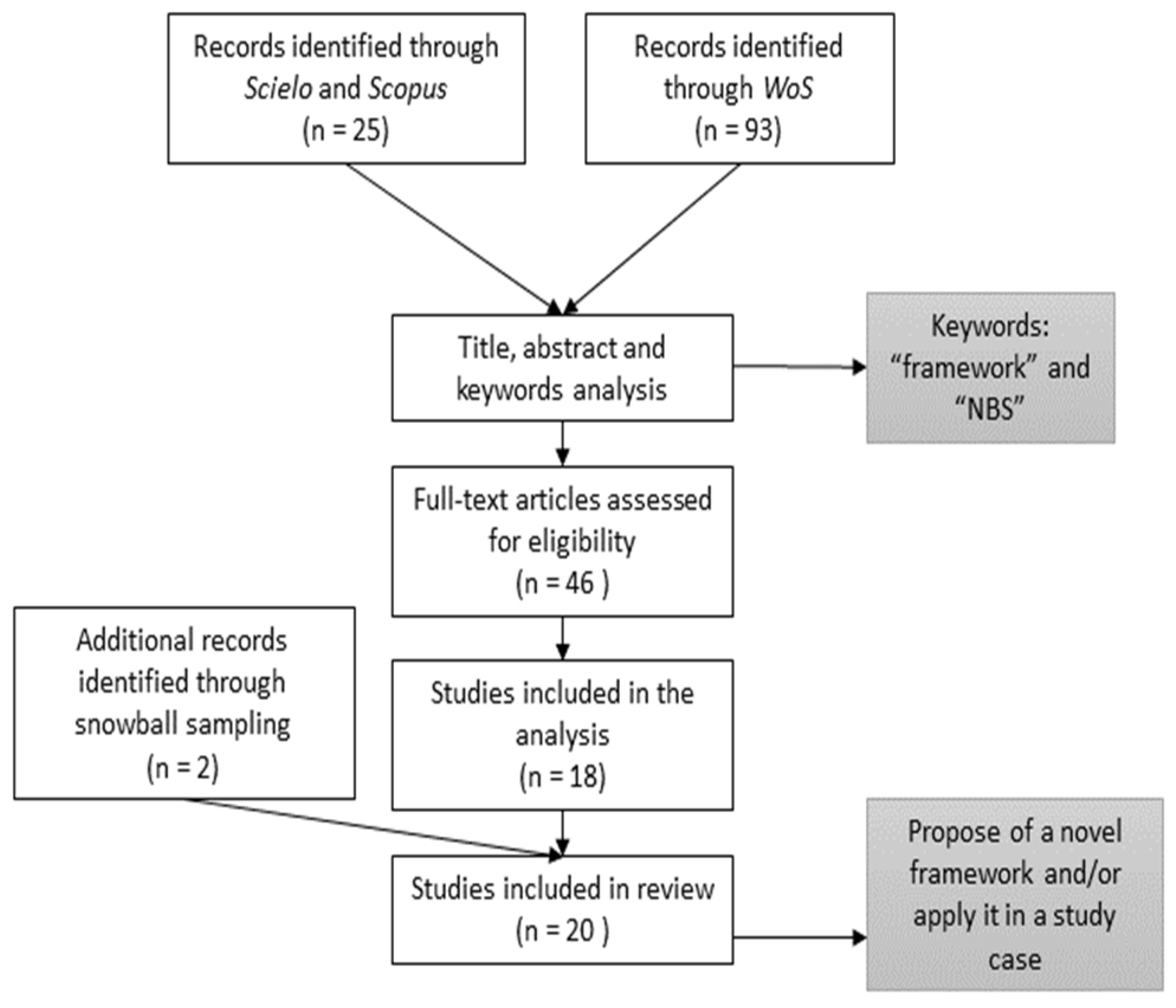
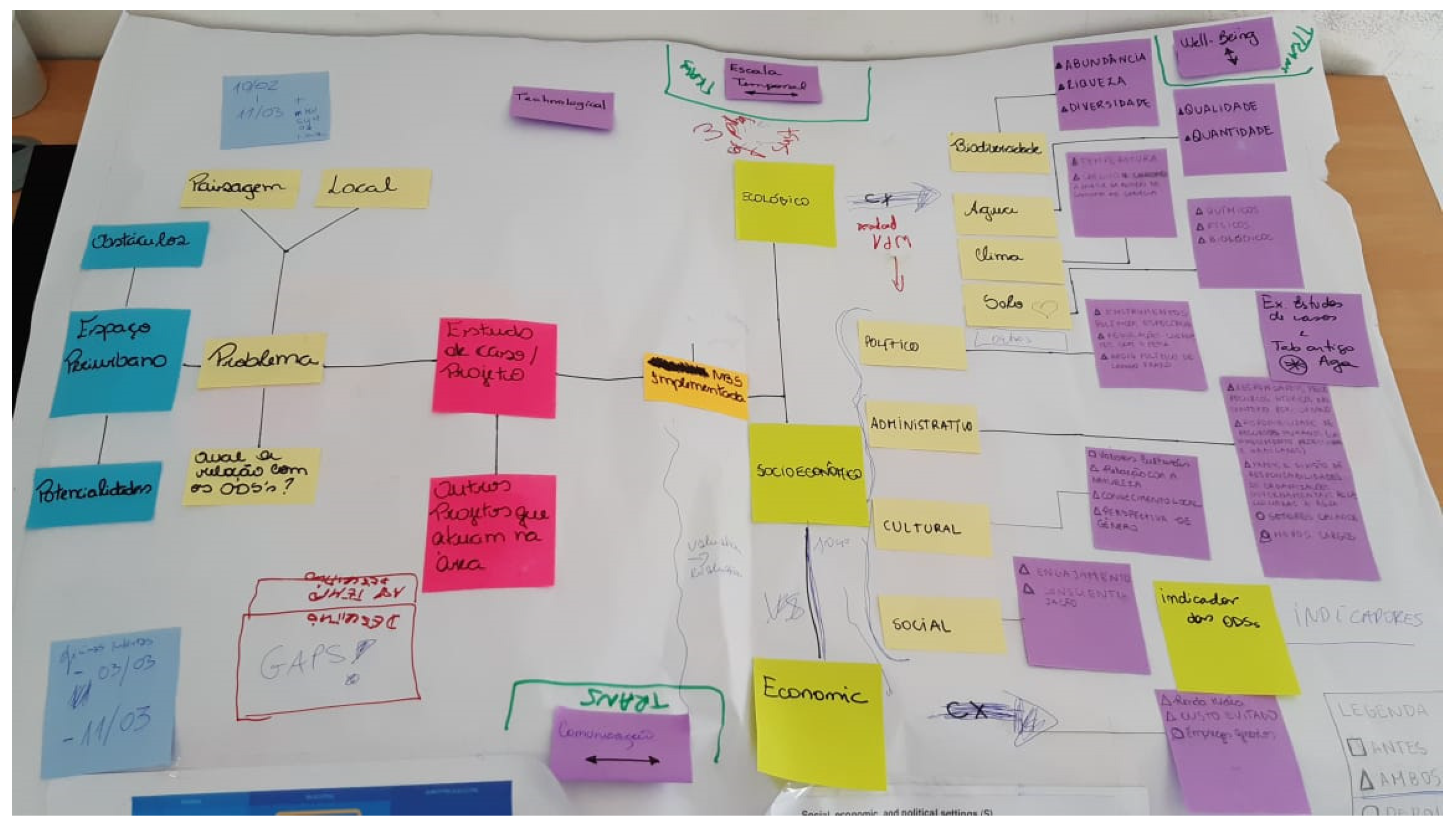
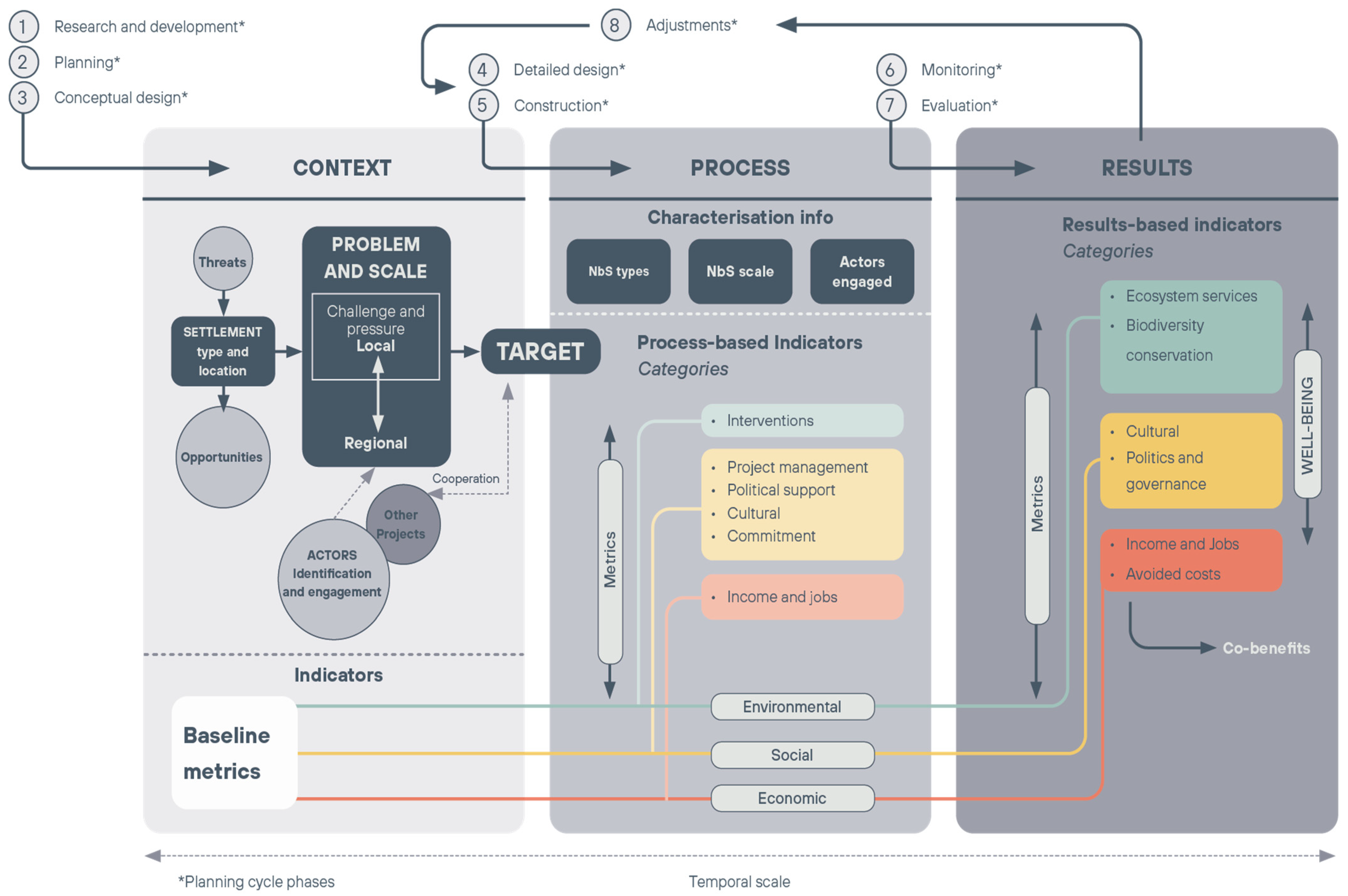
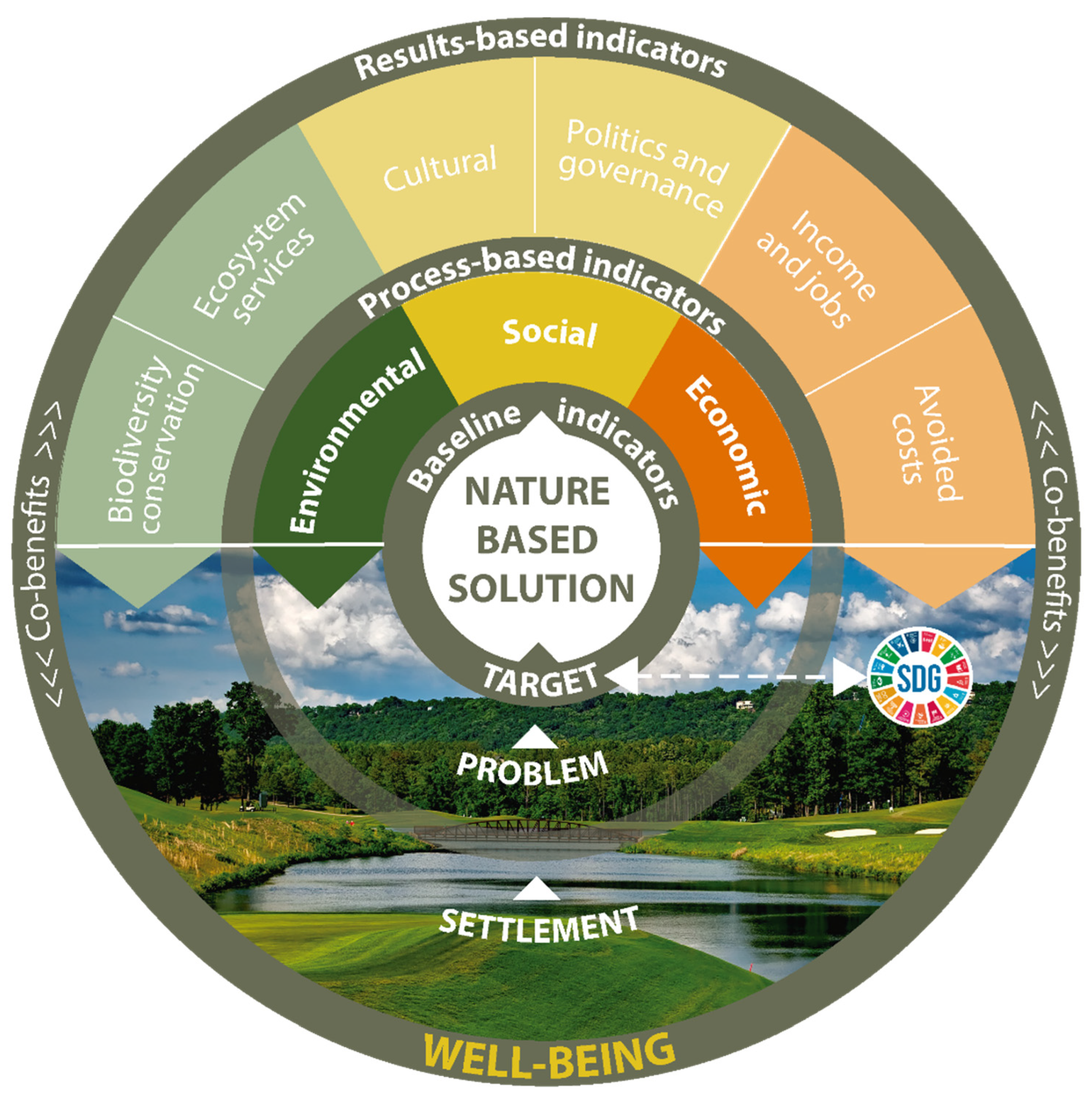
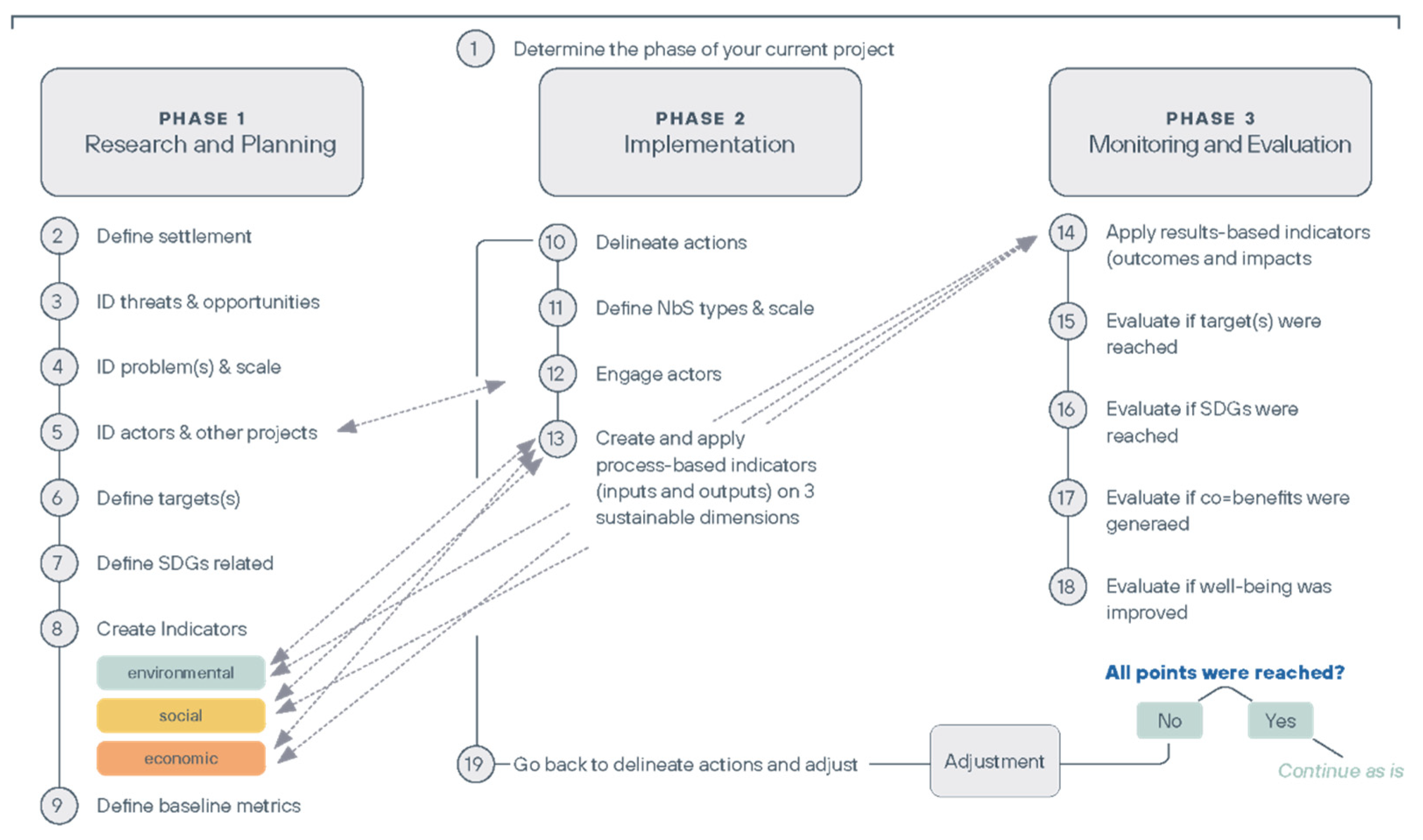
| Type | Dimension | Category | Examples |
|---|---|---|---|
| Process-based indicators | Environmental | Interventions | Number of trees seedlings planted |
| Social | Project Management | Number of people participating in the NBS project | |
| Political Support | Number of laws and policies developed or reformed | ||
| Cultural awareness or education | Incorporation of cultural values and perceptions | ||
| Commitment | Continuous participation in the NBS process | ||
| Economic | Income and Jobs | Number of jobs created directly | |
| Result-based indicators * | Environmental | Provisioning ecosystem services | Streamflow |
| Regulation and maintenance ecosystem services | Erosion prevention | ||
| Socio-cultural ecosystem services | Recreational use of green spaces | ||
| Biodiversity conservation | Biodiversity index | ||
| Social | Cultural | Local perception of environmental improvements | |
| Politics and governance | Improvements/adjustments to existing laws | ||
| Economic | Income and jobs | Property betterment | |
| Avoided costs | Water treatment avoided costs |
| Planning Cycle Phases | Definitions |
|---|---|
| Research and development | An activity that depends on a specific question or objective. It could be R&D to test solutions in the lab/meso or pilot scale or desk work investigating the site to implement a possible NBS. |
| Planning | This is a more general term and is related to the planning that is needed for the intervention. It encompasses desktop studies and preliminary investigations to assess a potential intervention(s). It can also include the involvement of stakeholders to check the suggested NBS is viable at the site (feasibility study). It may include a prediction of the expected expenses and the planning of actions for the NBS implementation. |
| Conceptual design | This is the moment when the urban planners, landscape architects and engineers (among others) with relevant backgrounds make the overarching design of the NBS. This moves the NBS from what is viable to a specific solution (conceptual). |
| Detailed design | The actual design of the intervention (engineering calculations, models completed) is most often communicated as technical drawings that can be directly used for the construction of the intervention. |
| Construction | The physical construction of the NBS by those including construction companies, NGOs and local people at the project site. |
| Monitoring | The process of collecting and analyzing data and information aiming to identify changes in relation to a baseline. |
| Evaluation | The process of examining the monitoring data to identify the influences/impacts of the project activities and summarize lessons learned. |
| Adjustments | The process of adjusting project activities to improve results. |
Publisher’s Note: MDPI stays neutral with regard to jurisdictional claims in published maps and institutional affiliations. |
© 2022 by the authors. Licensee MDPI, Basel, Switzerland. This article is an open access article distributed under the terms and conditions of the Creative Commons Attribution (CC BY) license (https://creativecommons.org/licenses/by/4.0/).
Share and Cite
de Lima, A.P.M.; Rodrigues, A.F.; Latawiec, A.E.; Dib, V.; Gomes, F.D.; Maioli, V.; Pena, I.; Tubenchlak, F.; Rebelo, A.J.; Esler, K.J.; et al. Framework for Planning and Evaluation of Nature-Based Solutions for Water in Peri-Urban Areas. Sustainability 2022, 14, 7952. https://doi.org/10.3390/su14137952
de Lima APM, Rodrigues AF, Latawiec AE, Dib V, Gomes FD, Maioli V, Pena I, Tubenchlak F, Rebelo AJ, Esler KJ, et al. Framework for Planning and Evaluation of Nature-Based Solutions for Water in Peri-Urban Areas. Sustainability. 2022; 14(13):7952. https://doi.org/10.3390/su14137952
Chicago/Turabian Stylede Lima, Ana Paula Morais, Aline F. Rodrigues, Agnieszka Ewa Latawiec, Viviane Dib, Fernanda D. Gomes, Veronica Maioli, Ingrid Pena, Fernanda Tubenchlak, Alanna J. Rebelo, Karen J. Esler, and et al. 2022. "Framework for Planning and Evaluation of Nature-Based Solutions for Water in Peri-Urban Areas" Sustainability 14, no. 13: 7952. https://doi.org/10.3390/su14137952
APA Stylede Lima, A. P. M., Rodrigues, A. F., Latawiec, A. E., Dib, V., Gomes, F. D., Maioli, V., Pena, I., Tubenchlak, F., Rebelo, A. J., Esler, K. J., Oen, A. M. P., Ramírez-Agudelo, N. A., Bosch, E. R., Singh, N., Suleiman, L., & Hale, S. E. (2022). Framework for Planning and Evaluation of Nature-Based Solutions for Water in Peri-Urban Areas. Sustainability, 14(13), 7952. https://doi.org/10.3390/su14137952







